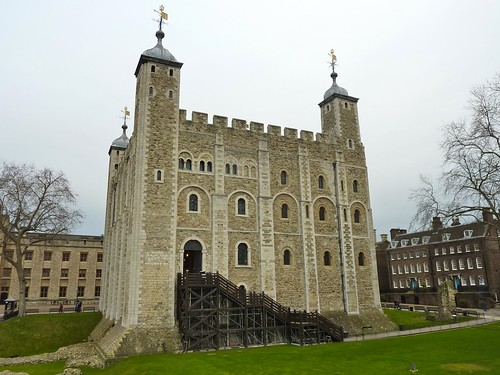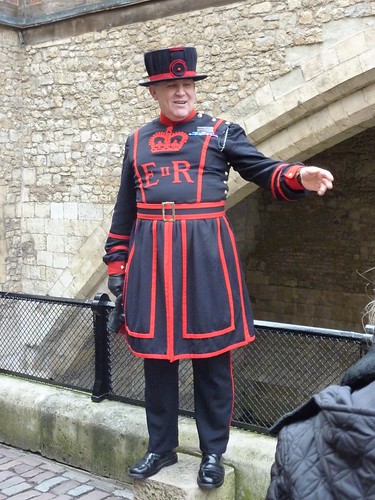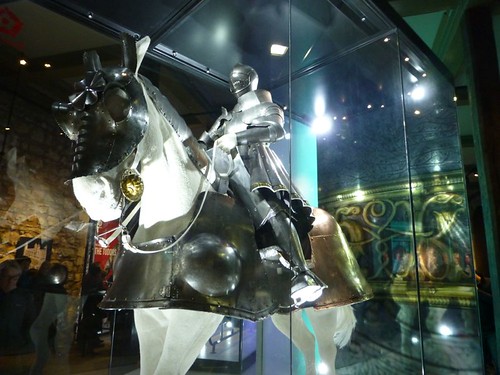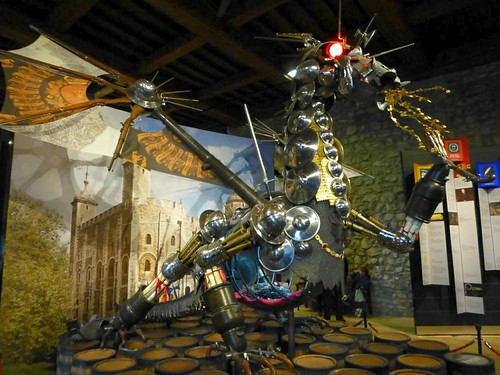It was a long week here at GSWPL World Headquarters. First there was a trip home from Canada that went so disastrously badly that it really deserves a whole blog post, which I may do when I've worked through the whole thing in therapy. For now suffice it to say that I arrived about 26 hours later than scheduled after two cancelled flights and a detour through Houston, Texas. (Also, if you have any choice in the matter, please, for the love of God, DO NOT fly with Lufthansa.) I barely got back in time to greet my friends Karen and Steve who arrived at King's Cross Station on the Eurostar about six hours after I arrived at Heathrow. We then proceeded to cram a month's worth of sight-seeing into six days which was lots of fun but generally exhausting. All this means that I'm a bit done in, but have lots of touristy things to blog about. So today it's (finally) time to dive into one of London's top attractions, which is also one of four UNESCO World Heritage Sites in the city: The Tower of London.

In case you didn't know this (but really, how could you NOT know this?) the Tower of London is a bloody great castle on the north bank of the Thames, as shown in this fancy panoramic photo from Karen and Steve's fancy new camera.
It's more properly known as Her Majesty's Royal Palace and Fortress the Tower of London, and has existed in one form or another since just after the Norman conquest in 1066. Started by William the Conqueror as a means of exerting control and displaying power when he gained the throne, the first building constructed was the White Tower.




In case you didn't know this (but really, how could you NOT know this?) the Tower of London is a bloody great castle on the north bank of the Thames, as shown in this fancy panoramic photo from Karen and Steve's fancy new camera.
It's more properly known as Her Majesty's Royal Palace and Fortress the Tower of London, and has existed in one form or another since just after the Norman conquest in 1066. Started by William the Conqueror as a means of exerting control and displaying power when he gained the throne, the first building constructed was the White Tower.

The White Tower, whose walls range between 11 and 15 feet thick. It's currently the home of seemingly endless floors of exhibits on arms and armour, and the gift shop, which is quite appropriately housed in the lowest level of the White Tower, once a torture chamber.
Through the medieval period the Tower was expanded, gaining an inner and outer curtain wall and a moat. Different monarchs built, modified, added to and changed the tower throughout its history and it's been used not just as a defensive fortification but also a royal residence, treasury, observatory, mint (the kind that makes money, not the after-dinner variety), zoo, armoury, military barracks and, of course, a prison. The current look of the fortress is largely thanks to 19th century works that restored several of the older towers but also (controversially) removed several “important structures” to generally make the place more pleasing to the Victorian eye. As early as 1901, more than half a million tourists were visiting the Tower every year. Today the figure is two million, which, judging from the usurious admission fees, means they must be positively raking it in.
Karen and Steve and I headed to the Tower first thing in the morning. It opens at 10am and we arrived not long after, which was a wise thing because it filled up fast after lunchtime. We nosed around the place for a little before gathering for the 11am Yeoman Warder’s tour. The Yeoman Warders of the Tower are popularly known as Beefeaters (the ones on the gin bottle) and are recognisable by their fancy dress. They are NOT, as our man took pains to point out, costumed tour guides. In fact they’re properly known as the Yeoman Warders of Her Majesty’s Royal Palace and Fortress the Tower of London and Members of the Sovereign’s Body Guard of the Yeoman Extraordinary, which is a bit much to put on a epaulette if you ask me. All Yeoman Warders are retired senior non-commissioned officers with at least 22 years service in a branch of Her Majesty’s armed forces, each of whom have been awarded the Long Service and Good Conduct Medal. In total there are 37 Yeoman Warders and one Chief Warder who actually live with their families in accommodation within the Tower, which is unbelievably cool.

Accommodations within the Tower. Apparently they do pay utilities and Council Taxes, but their rent is only £100/month. They're also required to own their own property outside the Tower, so they have somewhere to go when they retire.
Technically, the Yeoman Warders are responsible for looking after any prisoners in the Tower and for safeguarding the Crown Jewels, but in practice they act as tour guides and are a tourist attraction in their own right. The Yeoman Warder tours are certainly a highlight of any visit to the Tower and are (thankfully) included in the cost of the ticket. Our guide was the 389th Warder sworn in since the order was formed by Henry VIII in 1485 and as a former Sergeant Major in the Army he had no difficulty in making himself heard. Apparently he's known around the Tower as "Whispering Dave".
Whispering Dave, standing in front of the Water Gate. He's in his everyday uniform. The fancy red one from the gin bottle is reserved for special occasions. (Also, apparently the Beefeater Gin people send each Yeoman Warder a bottle on his or her birthday and take them all for Christmas lunch. Nice.)
The Yeoman Warder tour was excellent - just the right mix of fact and fun and just the right length (about an hour). Whispering Dave told us about a the moat, which essentially operated as a big open sewer flushed by the tide each day. Thankfully it's now dry and currently hosting a public skating rink. We also learned about the prisoners held at the Tower and the executions on Tower Hill, just to the North of the Tower itself. Most executions were hangings, since beheadings were reserved for the gentry. And you needed to be very special to be beheaded inside the tower itself. The most famous person separated from his or her head inside the Tower was Anne Boleyn, who was executed by a swordsman imported from France in 1536. She's buried in the Chapel of St. Peter ad Vincula, inside the Tower, which we visited with Whispering Dave (which, mercifully, had seats and heating).
And for those who think that the Tower has merely been a tourist attraction since the 19th century, you might be surprised to learn that in 1952 East end London gangsters Ronnie and Reggie Kray were held there. Also, in the 1930s the Bell Tower was refurbished just in case they needed somewhere to stick Adolf Hitler, and the Queen's House in the Tower was used to hold Rudolph Hess for a few days.
While wandering around with Whispering Dave we also saw these guys:
There are currently seven ravens in residence at the Tower of London, tended by a Yeoman Warder called the Ravenmaster. The ravens are maintained at the Tower because of a legend that claims that if the birds ever leave the Tower will fall, and the monarchy along with it. So powerful was this legend to King Charles II that when he was asked by the Royal Astronomer to remove the ravens from the Tower because they were interfering with his work the King ordered that at least six birds should always remain, and had the Royal Observatory relocated to Greenwich. Now the ravens have their lifting feathers trimmed, which doesn't stop them flying but unbalances them enough that they tend not to stray too far (though this didn't stop one raven, appropriately named Grog, from escaping to an East End pub called the Rose and Punchbowl in 1981).
After Whispering Dave's tour we headed straight to see the Crown Jewels, which are housed in the Waterloo Barracks, built in 1845. Judging by the fences installed to corral tourists into a queue of epic length, we must have timed things perfectly and fairly breezed through. Unsurprisingly, no photos are allowed in the exhibit, which starts with several rooms of history about the coronation ceremony and displays of less revered artefacts, presumably to give you something to look at when you're shuffling forward in an endless queue. The Crown Jewels displayed at the Tower are the genuine article, still used by the Queen on ceremonial occasions, a fact attested to by the impressive steel vault doors you pass through en route to the jewels themselves.
The most important pieces include the Imperial State Crown, which is worn for the opening of parliament; the Sovereign's Sceptre, adorned with the enormous 530 carat Great Star of Africa diamond; the solid gold St. Edward's crown, most recently used at the coronation of Queen Elizabeth II in 1953; and the Crown of Queen Elizabeth the Queen Mother, which is set with the infamous Koh-i-noor Diamond. The room housing the most precious pieces has two tiers. You can linger as long as you like on the upper tier, but, amusingly, if you want to get up close to the display cases on the lower tier you have to stand on a moving walkway that slowly slides you past each case, thus ensuring you don't linger and back the queue up all the way across Tower Bridge. Other than the dazzling opulence, I found the most interesting thing about the Crown Jewels was their obviously handmade quality. Solid gold is a bit dull when compared to shiny gold plastic, and the hundred of gems set into each piece weren't always perfectly lined up like they'd be in a machine-made knock-off. They are, in short, both stunning and charmingly imperfect.
When we emerged from the darkened splendour of the Crown Jewels we ventured into the White Tower, but by this time all three of us were flagging; it was definitely lunchtime. (Though in fairness I'd been whining about being hungry since about ten minutes after we'd arrived. I was also dying for a coffee, which I could have got at the traditional 13th century espresso bar between the southern inner and outer walls.) However, this full-time tourist business is not for the faint of heart so we soldiered on through the White Tower, William the Conqueror's first edifice and the central defensive structure of the whole complex. Among other things, it's thought to be the place where the princes in the Tower were interred, possibly after being murdered by Richard III (indeed, two small skeletons were found there in 1674). It currently houses the aforementioned endless displays of arms and armour, including a suit of Henry VIII's armour, a whole lot of weapons, a ridiculously garish dragon sculpture.
One of the random displays of armour
Inexplicable dragon sculpture with claws made of revolvers. What?
After making it through that we had to brave the gift shop, which was mostly awful. However, it did have a really excellent build-it-yourself paper sculpture of an executioner that actually moved. When you turned the crank the executioner lowered his axe and the poor guy's head actually came off and fell into a basket! Excellent. I can't believe I didn't buy that.
How great is that?

Also, Steve tried on a funny hat.
We tried to go around a short stretch of the castle's battlements, but by then the crowds were ridiculous. After ending up in a bottleneck at Brass Mount tower we bailed out by rebelliously ignoring the "No Access" sign on a stairway that led us back down to the castle grounds and then to freedom/lunch. We'd been at the Tower for about four hours. If the weather had been warmer, and if Steve and Karen hadn't had other things to see that day, and if we'd been smart enough to bring snacks, and if we didn't mind battling the crowds, it would have been quite easy to have stayed for several hours more. There's a whole museum dedicated to the Royal Regiment of Fusiliers that we didn't even glance at, and we could have done a guided tour of the White Tower, and there was a special exhibit on the Royal Menagerie of animals that was housed in the Tower for 600 years... and so on. As it was we were all happy to move on, Karen and Steve for a quick lunch and thence to Westminster Abbey, me home for a much-needed nap. After all there was a lot more to come, which you'll hear about in next week's blog.








0 Comments:
Post a Comment